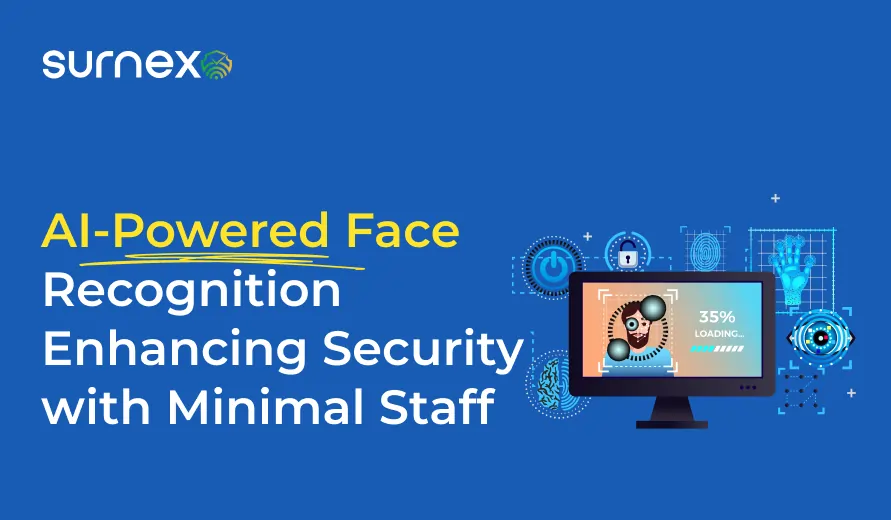AI-Powered Face Recognition: Enhancing Security with Minimal Staff

In today’s fast-paced world, security remains a vital concern for businesses, public spaces, and residential areas. Traditional security methods, such as manual monitoring and password-based systems, often need significant human involvement and can be prone to errors. With the rise of facial recognition technology, organizations can now maintain a secure environment while reducing the size of security teams. This article explores how AI face recognition works, its applications, and the advantages of integrating a facial recognition system into existing security setups.
How Facial Recognition Technology Works
A facial recognition system uses advanced algorithms to identify and verify people based on facial features. The process begins by capturing a digital image of a person’s face with a camera. The system then measures key points on the face, such as the distance between the eyes, the shape of the jawline, and the contour of the cheekbones. These measurements create a unique facial signature, which is stored in a database.
When someone enters a secured area, the system compares the live image with stored facial data to confirm a match. This enables the system to verify identities in real time. Modern AI surveillance systems can run 24/7, instantly identifying individuals and alerting security personnel if an unauthorized person attempts to access. Different from traditional security methods, this technology doesn't rely solely on human observation, which can be limited by fatigue or distraction.
Applications in Various Industries
Facial recognition technology isn't just for high-security zones; it has applications across various industries.
Corporate Offices: Large offices can use a face recognition system to manage entry points, replacing access cards and PINs. Employees can enter the building just by having their faces scanned, which reduces time spent on manual checks.
Retail Stores: In retail, a facial recognition system helps identify known shoplifters and tracks customer traffic patterns. This enables store managers to allocate staff more effectively, enhancing security without adding more personnel.
Airports and Transportation: Airports are ideal places for deploying AI surveillance. Facial recognition can accelerate boarding, confirm passenger identities, and enhance safety overall. The system automatically detects suspicious activity, reducing the need for extensive staff at entry points.
Healthcare Facilities: Hospitals and clinics use facial recognition technology to make sure only authorized personnel access sensitive areas like pharmacies or patient records. This cuts down on the need for a large security staff while keeping patient safety intact.
Educational Institutions: Schools and universities are increasingly using AI face recognition to monitor attendance, control campus access, and secure restricted areas. This enables administrators to concentrate more on student welfare instead of spending too much time on manual security checks.
Advantages of Minimal Staff Deployment
One of the main benefits of using AI surveillance systems is the ability to operate with fewer staff members while maintaining high security standards. Key advantages include:
Continuous Monitoring: Unlike human guards, facial recognition systems can operate nonstop. They provide continuous monitoring, which reduces the risk of security gaps.
Faster Identification: The system can instantly recognize authorized personnel and spot unknown individuals. This accelerates the verification process compared to traditional methods that rely on ID cards or manual procedures checks.
Reduced Labor Costs: Organizations can keep secure premises without hiring large security teams. Fewer staff members are needed to oversee operations, resulting in cost savings.
Accurate Records: A facial recognition system maintains accurate records of entries and exits. This can be essential for investigations or audits, as it offers verifiable data that is less susceptible to human error.
Scalability: Businesses of all sizes can adopt facial recognition technology without significant modifications to their existing security systems. Small offices, large corporate campuses, and public facilities can all gain advantages from automated monitoring.
Challenges and Considerations
While AI face recognition offers many benefits, organizations must also consider potential challenges.
Privacy Concerns: Collecting facial data can raise privacy concerns. Clear policies should be established to ensure that data is stored securely and used responsibly.
Lighting and Camera Quality: A system’s accuracy relies on camera quality and environmental conditions. Poor lighting or low-resolution cameras can decrease recognition efficiency.
Database Management: Maintaining an up-to-date facial database is crucial. Regular updates ensure the system accurately recognizes people and prevents unauthorized access.
Regulations and Compliance: Different countries have different laws about biometric data. Organizations should follow local rules to prevent legal issues.
Future Possibilities
The capabilities of facial recognition technology continue to grow. Advanced AI surveillance can now identify unusual behavior, recognize emotions, and analyze patterns over time. Combining it with other security systems, like motion sensors or smart locks, creates a layered approach that boosts overall safety.
For businesses aiming to cut reliance on human monitoring, AI face recognition offers a promising solution. The integration of automated identification and data tracking helps organizations enhance security and reduces errors and delays.
Final Words
Integrating facial recognition technology into security operations helps organizations ensure safety while reducing staffing needs. From corporate offices to airports and healthcare facilities, a facial recognition system offers precise, real-time monitoring that boosts operational efficiency. As AI surveillance systems continue to improve, they will become even better at managing complex security issues with minimal human input.
The adoption of AI face recognition marks a major shift in how security is managed. It decreases dependence on traditional methods, lowers operational costs, and guarantees that access control is accurate and dependable. By carefully addressing privacy, regulatory, and technical concerns, organizations can implement this technology successfully and create a safer environment for employees, customers, and the public.
Experience AI-Powered Security Today
Discover how our intelligent cameras can transform your home security with advanced AI features, easy setup, and 24/7 protection.